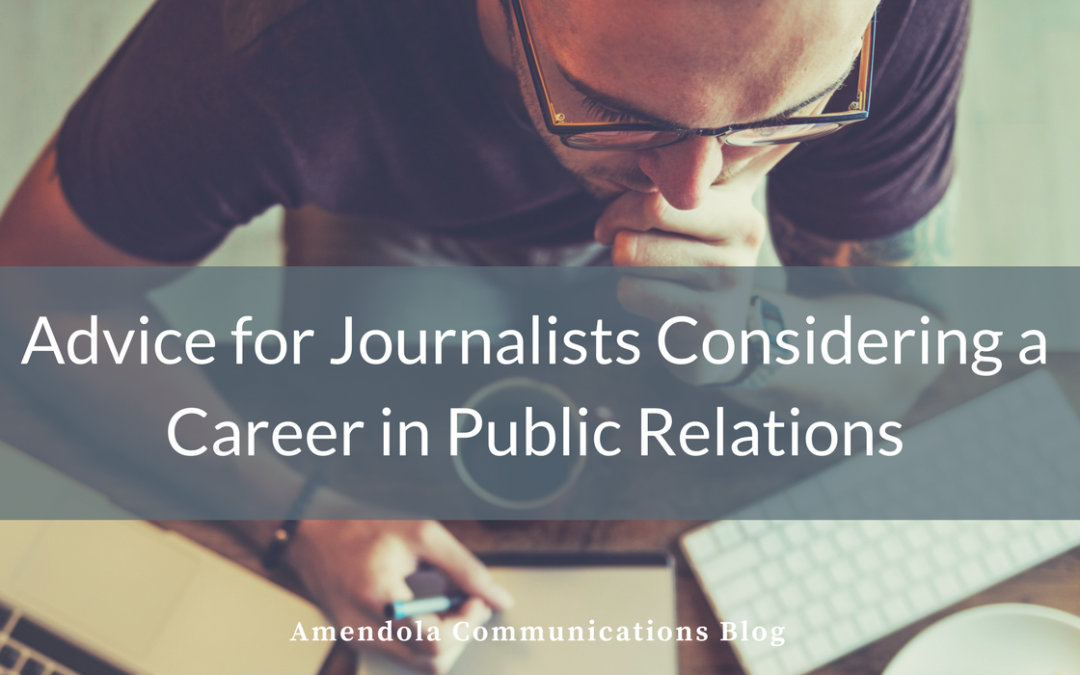
Advice for Journalists Considering a Career in Public Relations
Admit it, reporters and editors: Many of you are a little curious to learn about tips for journalists considering a career in public relations, or at least you have been at some point.
That’s OK. No one could blame you and you’ve got plenty of reasons:
- Newspapers have hemorrhaged so many jobs over the last 10 years that a major industry trade group threw in the towel on tracking job losses.
- Before you say, “Everyone knows newspapers have been bleeding jobs, but that’s been offset by growth at digital publishers,” consider one factor: That statement isn’t true. Hiring at digital media outlets “pales in comparison to the number of journalists laid off in the newspaper industry,” according to Columbia Journalism Review.
- The occupation “desktop publisher” (sounds a lot like a journalist to me) appears on the U.S. Bureau of Labor Statistics list of fastest-declining occupations between 2014 and 2024, along with telephone operators, mail carriers, sewing machine operators and a lot of other occupations that aren’t very appealing to young people.
- Most disturbing, perhaps, is the absolute dominance of Facebook and Google in the advertising market. Between 2012 and 2016, the two giants alone accounted for 70 percent of the growth of ALL advertising revenues, a figure which is inclusive of radio and TV ads. If we focus only on the U.S. digital advertising, the numbers are even more bleak: Last year, Google and Facebook accounted for an “astounding” 99 percent of the growth in that market last year.
- Further, with Facebook and Google controlling 65 percent of new digital ad revenues, don’t expect a big surge in hiring from other digital publishers any time soon.
No doubt, it’s hard out there for a journalist. So, naturally, you may be thinking about transitioning to a new career that builds on many of the skills you’ve developed as a reporter and editor writing, interviewing, editing, researching and the like. Lots of us have been there.
I spent nearly a decade in journalism, and worked in corporate communications and public relations for about the last four years. As someone who has seen how the sausage is made on both sides of the industry, I offer the following thoughts, observations and tips for journalists who are interested in a career in public relations.
Continue to think like a journalist: That’s not to say that after starting in PR you need to think exactly like you did as a journalist. Once you acquire more PR experience you’ll have an advantage over others in the field: You’ll have the ability to think both as a journalist and PR professional. Your guidance on what does or does not capture media interest will serve you very well with clients, who typically have a wealth of knowledge and experience in their own industry and are anxious to learn how journalists work.
Become more client-focused: Journalist are a bit like a lone wolf: Largely self-reliant and able to chart their own course to find the nourishment they need to survive. For journalists that nourishment comes in the form of stories that will attract readers and clicks (“publish or perish,” after all). Corporate culture is a bit of change from that, and in many cases, the change is positive. You’ll actually get to work as part of a team rather than primarily writing articles by yourself although that cooperation with and reliance on others may take some getting used to at first.
Another difference is the number of approvers. In journalism, it’s essentially you and your editor. In PR, there is your internal team, and there is the client team, which often includes members of the marketing department as well as individual subject matter experts. Everyone in the process brings their own perspective, which may not always align with what you may have been taught in journalism school. That’s ok, though. It helps you expand your universe and the ways you can communicate.
Stress out less about deadlines: No matter the profession they’re in, everyone seems to think that they’re faced with constant deadline pressures and always rushing to get to the next task, whatever that task may be. However, in my own experience from working in journalism and with corporations, corporate deadlines are usually longer than “today” (unlike journalism), and are more likely to get pushed back when needed. Why might this be? I suspect it comes down to organizational focus. A media outlet or publishing company is in the business of publishing news. Articles are the “widgets” that these companies produce to pull in revenues from advertisers.
For corporations that are clients of PR firms, publishing content is not their primary focus. The content is part of a larger plan with many moving parts. In other words, content isn’t the “widget;” it’s support for the widget, which means content deadlines are dependent on when the widget is ready. Further, corporations typically have more layers of approval that any given piece of content must pass through before seeing the light of day.
Get used to being the pursuer, instead of the one being pursued: As a journalist, PR professionals are constantly vying for your attention, all looking to obtain media coverage for their clients. It’s ok to confess that that felt good sometimes. Well, forget about that feeling. In PR, the tables have turned and you may be expected at times to pursue inexperienced journalists from small media outlets who nonetheless aren’t particularly interested in what you have to say at the moment. If your ego can’t handle that (not to mention lots of your pitches being met with rejection or indifference) PR probably isn’t the best field for you.
Maintain your journalism contacts: Attending a conference or other gathering with a number of fellow journalists? Grab some business cards not only from potential sources you’ll be writing about, but from other reporters, too. Those journalist contacts you make will serve you very well in public relations, and because they’ve seen you as one of themselves, they may respect you a bit more when you’re pitching or sharing story ideas.
Confession time – this is one area where I fell short as a reporter. When I attended conferences, I was so preoccupied with building my network of sources and finding stories that I neglected to interact as much as I should have with journalists – aside from the times we spent together sitting in the press area. So take a step back from your articles, interviews and research and spend some time getting to know the reporters you’re working shoulder-to-shoulder with. If and when you join a PR firm, you’ll be glad you did because you’ll have a pre-built, solid network of journalist contacts the first day you walk in the door. And that’s invaluable to the clients who are depending on you to get their stories told.
These are just one ex-reporter’s tips for journalists considering a career in public relations. There are many paths to PR, and journalism is but one. Regardless of how you come to PR and how you obtain the necessary skills, the abilities that journalism cultivates – writing, interviewing, editing, researching will play a critical role in your success.
